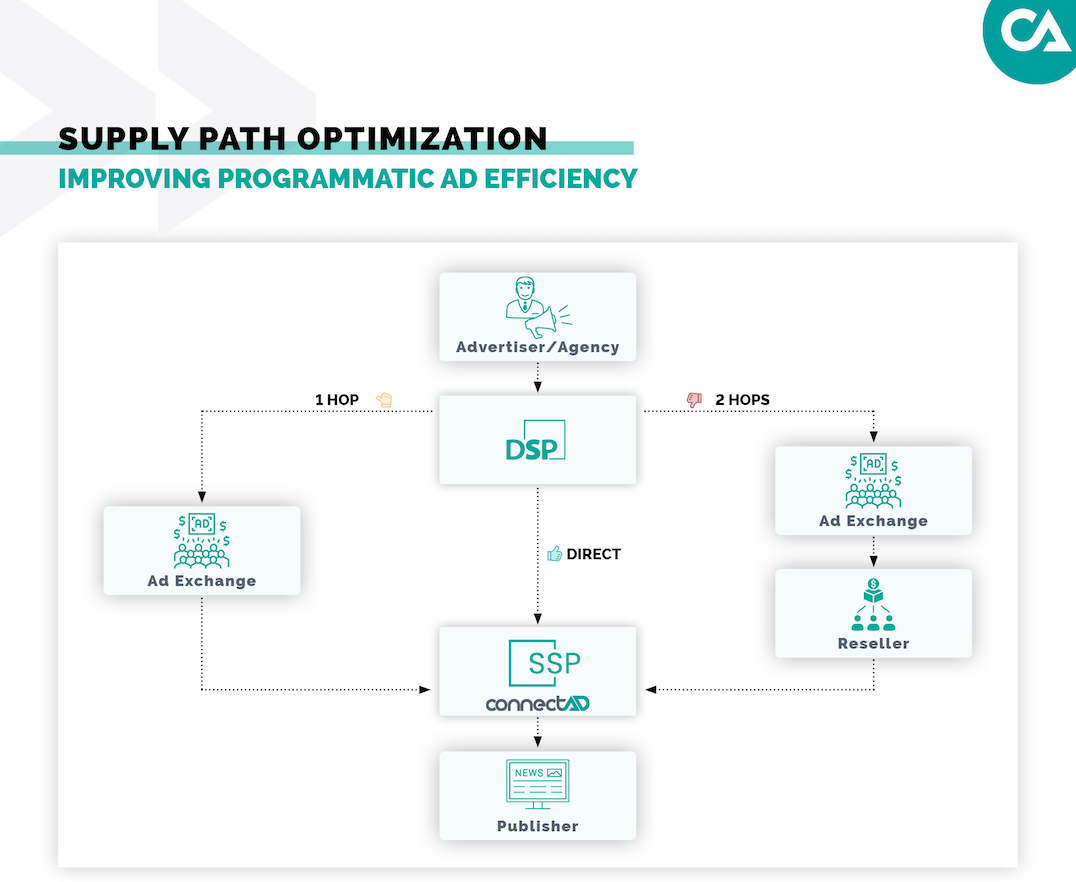Supply Path Optimization (SPO) is an important focus in programmatic advertising. However, it is also one of those areas that repeatedly causes considerable confusion. At its core, SPO is about simplifying the supply chain between advertisers and publishers. The goal is to eliminate superfluous middlemen and reduce redundancies. But what does this mean in detail? How did it get this far in the first place? And: How do we deal with SPO issues at ConnectAd?
What is Supply Path Optimization?
To explain SPO works best with a well-known saying: All roads lead to Rome. Right? Right. But: Some roads are shorter than others. Some might be bumpy, some have higher tolls and others better sights. SPO helps to find the best way to Rome in an opaque labyrinthine road network. The best way is ideally short, transparent at all times, and can also be walked as efficiently as possible.
SPO is a strategic approach to media buying that prioritizes certain supply paths over others by addressing some or all of the complexities associated with the bidding process. The ultimate goal is to provide greater transparency in programmatic advertising through a better understanding of what goes on behind the scenes of all bid requests. The logic is quite simple: Those who know their supply chain can uncover wastage and optimize ROI. Thanks to the IAB's efforts, new industry standards such as ads.txt and sellers.json are also forcing the sell side to identify its place in the supply chain.
The history of SPO or how we got here in the first place
The need for SPO is related to the birth of header bidding. Header bidding became an industry standard in 2014 and that’s when this whole mess slowly but surely began to develop until we couldn’t ignore it any longer. On the one hand, header bidding ushered in a new phase of advanced programmatic advertising by helping publishers better assess the true value of their inventory and generate higher revenues as they were finally able sell their ad inventory at the highest price possible. On the other hand, it has led to a significant increase in auction duplication, with the same ad being served simultaneously by multiple sellers, which creates an additional layer of complexity in the supply chain. It can even occur that the advertisers unknowingly compete against themselves. Therefore, buyers need to determine which intermediaries are truly adding value. And this is how supply path optimization has emerged.
How SPO works and why it benefits everyone
While efficiency may be one of the main goals of SPO, there is no simple rule for how to achieve it. Moreover, efficiency and campaign performance look slightly different for every buyer. That’s why SSPs adopt different strategies and combinations for SPO. To reduce auction duplicates and ad discrepancies they often rely on an individual mix of manual analysis and different algorithms which consider multiple factors to optimize the delivery path, such as inventory type (web, mobile, app), ad viewability, historical performance or geography.
But as hard as buyers try to sort through the clutter in the ad tech supply chain and identify blind spots, without input from publishers or other vendors, they struggle to identify the most efficient connections and achieve optimal results. On the other hand, when publishers proactively reduce the clutter in their supply chains by reviewing their ads.txt files and encouraging their preferred demand partners to review their sellers.json files, they help to increase transparency and to create better connections between all stakeholders.
After all, the fewer intermediaries there are in the chain, the less value is lost. And that's good for everyone. For the advertiser, because he loses less of his ad spending, and for the publisher, because he receives significantly more of the advertising dollar! A win-win situation.

Our quality promise: one hop only!
At ConnectAd, we want to offer publishers the best possible monetization. BUT we can only do this if we ...
a) … provide our demand partners with the shortest path to our supply and
b) … provide the best supply quality. (FYI: We measure ad viewabilty here and subject our supply to internal scoring via our technology)
This results in a very clear position against any re-reselling of inventory and as a logical consequence our supply chain object may not include more than one hop. In concrete terms, this means that there is never more than one intermediary (one hop) in the supply chain between us and our demand partners.
As you can see we take this topic very seriously for both sides. For our publishers as well as for our demand partners, it's all about efficiency und we are glad that we are able to guarantee this efficiency. Wanna know more about this? Don’t hesitate to reach out!


